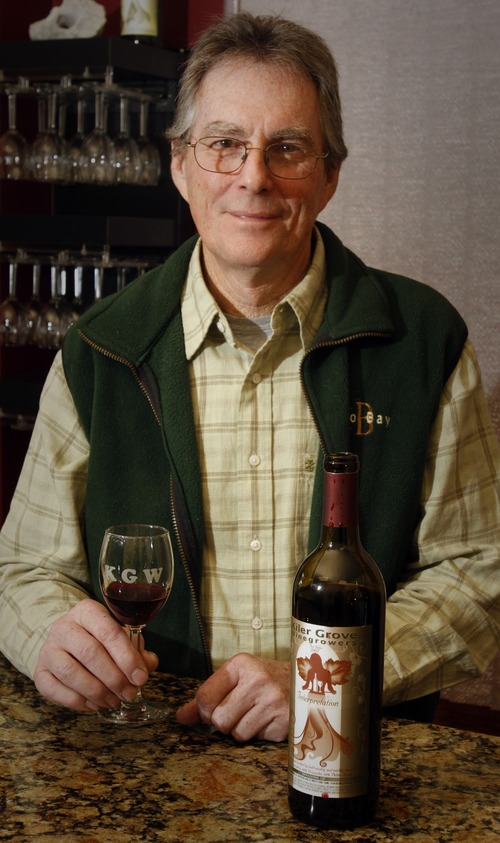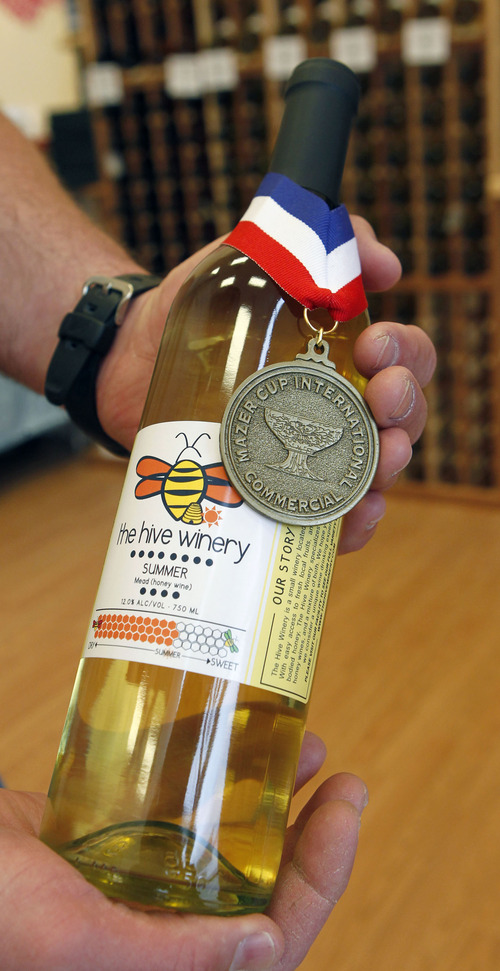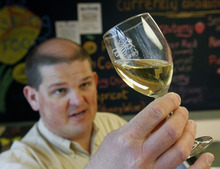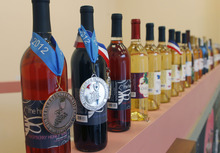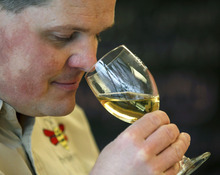This is an archived article that was published on sltrib.com in 2013, and information in the article may be outdated. It is provided only for personal research purposes and may not be reprinted.
Layton • Wine testers for the state rejected stocking a Utah-made summer honey wine in liquor stores, saying the mead made by a Layton winery had a "peculiar iodine and menthol character." Besides, state regulators noted, Utah retail outlets already were selling a similar variety from a California winery whose products are carried nationwide.
Yet a few weeks later, that same Utah wine made by The Hive Winery won first place in the 2013 Mazer Cup International in Colorado, one of the world's largest mead-only competitions.
The rejection of a local product is among the many hurdles Utah winemakers say they face in trying to doing business in a state that, at best, is ambivalent about their industry and, at worst, downright hostile toward it. From high taxes and fees to hard-to-navigate laws and almost no regulatory advantage for local producers, there's nothing easy about turning water and grapes into wine in Utah.
In neighboring Colorado, that state's emergent wine industry is thriving by comparison.
To be sure, the industry's stakes and impact are on a smaller scale in Utah — and much smaller even, than the state's 18 breweries. Unita Brewing Co., Utah's largest, produces 1.2 million gallons of beer each year, compared with an estimated 31,500 gallons from the all eight wine producers combined. Unita's annual revenue is $15 million, compared with $500,000 brought in by Castle Creek Winery, the state's oldest and largest producer.
Size aside, winemakers say their concerns are no less legitimate, and producers often first point to liquor laws enacted by the Legislature, an overwhelming majority of whose members belong to the The Church of Jesus Christ of Latter-day Saints, which teaches abstinence from alcohol.
At The Hive's 150-square-foot tasting room, law forbids imbibers with a glass of vino from strolling across an imagery line to where bottles of wine are offered for sale. Children are only allowed to be in the area of the store where the wine is sold, as long as they do not touch the wine bottles. And because The Hive doesn't have a restaurant license, the winery must close on holidays and Sundays — busy days for most producers.
Laws that restrict liquor sales and go as far as blocking drink preparation from the public's view have through the years been put in place by key lawmakers — with the behind-the-scenes endorsement of the LDS Church — who see Utah wineries in general and alcohol in particular as a public safety threat. Last year then-Senate President Michael Waddoups opposed increasing the number of gallons small wineries may produce and still get a tax break. He cited concerns over drunk driving and underage drinking in his successful push to defeat the proposal.
Waddoups, who has left the Legislature and is preparing to serve an LDS Church proselytizing mission in Italy, was not present earlier this year when the same proposal was defeated behind the support of other powerful legislators.
Little relief • Beyond the laws, Utah producers say the playing field could at least be more level for them if local wines got an extra point in the state taste test that determines which wines get on liquor store shelves. That small advantage wouldn't favor mediocre wines, but "it would give an agreeable product a little edge for the local producer," said Michael Knight, co-owner of Kiler Grove Wine Growers in South Salt Lake.
Utah regulators did put one Kiler Grove wine into state stores last year, but declined to renew the order. He's in talks with the state to get his products back into liquor outlets, but no agreement has been reached. Yet in March, three of its wines took medals in the South West Wine Challenge in Prescott, Ariz. Kiler Grove's 2009 Petite Sirah earned gold, its 2011 Saignée won silver and its 2009 Trebbiano brought back a bronze.
Vickie Ashby, spokeswoman for the Utah Department of Alcoholic Beverage Control, declined to discuss specific issues. She would say only that "as you know, by statute DABC cannot advertise or promote the consumption of alcoholic products. DABC does list products produced by Utah's wineries. It is not universal, but wherever floor space allows, a 'Utah's Own' or 'Utah Wine' section is used to merchandise Utah products. As small producers, all Utah wineries qualify for the reduced markup as provided in statute."
The state does give all small producers (not just those from Utah) a break on the markup it adds to a bottle of alcohol, 47 percent versus 86 percent for larger producers.
Small wineries are eligible for the break if they produce less than 20,000 gallons annually — compared with 100,000 gallons the U.S. government allows in calculating a lower federal excise tax. In addition, when small wineries go beyond the limit, federal tax increases are incremental — allowing for gradual production increases — while the state tax nearly doubles immediately.
Will Fryer, owner of Castle Creek Winery in Moab which produces about 12,000 gallons annually, recently bought a neighboring 5-acre vineyard, but he said he cannot expand much more if the state cap isn't eased because "it's not economically feasible to do so."
Even with the reduced markups, wineries in Utah pay hefty state taxes.
The Hive, for instance, paid $36,314 in taxes and fees to the state and $600 in taxes to the federal government last year, while maintaining a payroll of $21,700 for two part-time employees and its owner (who also has an engineering job).
Although Utah doesn't charge an excise tax, other charges and fees put state wine among the most heavily taxed in the nation, at $7.24 per gallon, according to the Distilled Spirits of America, whose calculations are recognized by the National Tax Foundation, a nonprofit, nonpartisan research organization based in Washington, D.C.
By comparison Alaska, which charges the nation's highest wine excise tax, is $2.50 per gallon, nearly three times lower than Utah's rate.
Losing ground • Other Utah regulations also work against small wineries as they endeavor to place their products in state-controlled liquor stores. Wineries are required to buy back slow-selling products at full retail price, making it impossible to adjust pricing by paying the difference in the wholesale price or buying it back for the lower price paid by the state.
Those slim profit margins have forced some local wineries to forgo Utah-grown ingredients for cheaper out-of-state concentrates and bulk wines, said Stacey Dezelsky, owner of Spanish Valley Vineyards in Moab.
"More and more vineyards are being ripped out, neglected, being put on the market for their land," said Dezelsky, whose property is for sale. "I don't have the financial resources to go upstate and lobby, but I'd like to see tax breaks given to wineries producing from Utah products."
Interest in growing grapes in the region where the borders of Utah, Colorado, Arizona and New Mexico meet dates to 1980 and a report by the University of Arizona, which published results of a seven-year study that promised salvation for failing family farms.
"Grape and Wine Production in the Four Corners Region" said wine grapes could grow vigorously in the sandy desert soil. It added that one acre of grapes would use 20 percent of the water needed to grow a field of alfalfa, Utah's No. 1 cash crop.
In 1989, Utah's first winery, Arches, opened and produced 1,500 gallons of wine — after an intense lobbying effort that culminated in a 1988 state law making it legal to make and sell wine.
Across the state line in Colorado, farmers also read the study and began planting grapes.
Today, Colorado has 1,000 acres of thriving grapes under cultivation (compared with Utah's 61 acres) and 100 wineries (Utah has 11). Colorado also has a full-time state viticultlurist who works out of Grand Junction, while Utah has no one in its agriculture extension offices who specializes in wine grapes.
"Why am I the go-to person for farmers needing information about growing grapes?" asked Dezelsky, who has been doing so since the 1990s. "It's because we have no state support."
Gov. Gary Herbert, who in recent months has pressed the Legislature to increase the number of available restaurant liquor licences in the name of economic development, has little say about Utah's wine industry and its challenges. He referred questions about issues raised by winemakers to the Governor's Office of Economic Development, which initially said it would comment but never followed through.
In Colorado, there has been no shortage of support. Its boom began taking shape in 1990, when the General Assembly passed legislation creating the Colorado Wine Industry Development Board under the authority of the Colorado Department of Agriculture. At the time, Colorado had only five licensed wineries. The board is funded by a tax on every bottle of wine, part of the proceeds of which also go promoting Colorado wine and to fund viticultural research at Colorado State University.
"The biggest thing that differentiates Colorado's wine industry from Utah's was the creation of the Colorado Wine Industry Development Board," said Doug Caskey, the agency's executive director. "It gave us a 10-year leg up over Arizona and New Mexico, and today all three states have a significant leg up over Utah."
About the same time the Colorado board was formed, the Utah Legislature was moving more cautiously, allowing Arches to have a tasting room, which is a standard feature of wineries worldwide. In 1992, lawmakers gave a tax break for wine sold at the winery after the LDS Church dropped its opposition to the bill.
Eternal hope • Little has changed in the ensuing years. For a Utah winery to sell its own wine, the tasting room technically becomes a state wine store. The winery pays the state a $3,800 licensing fee, plus an annual renewal fee of $1,400 to $2,900, based on the amount produced. The winery also pays 10 percent to the school lunch fund, 1 percent to the Department of Public Safety, plus a 5 percent administrative fee to the DABC. Instead of being sent to a liquor store, the wine stays on the grounds where it was made and where everything is built, owned, staffed and maintained by the winery (from which it can be sold).
"It's weird. I'm paying the state money when I'm producing the wine and selling it from my own winery," said Evan Lewandowski, who opened Ruth Lewandowski Wines in South Salt Lake last year. "But I have a crazy optimism that in my lifetime, things will change."
Hive owner Yahne shares that sentiment. He is pushing for state wine stores to highlight Utah wines with better product displays on the sales floor. He also would like to see restrictions eased on the quantity of wine that small growers must produce to become eligible for placement in state liquor outlets.
He and wife Lori, both geotechnical engineers, began making fruit wines as a hobby 15 years ago. Their first was from a bumper crop of Bing cherries from trees in the front yard of Yahne's parents' home in Clinton. By the end of this year, the Yahnes will have a selection of 40 speciality wines. They use locally harvested honey and fruits such as red raspberries and black currants from Weeks Berries of Paradise and Cox Honeyland in Logan.
Yahne rejects the notion of moving to a less-restrictive state, even after liquor cops conducted an undercover sting to test whether he would sell a discounted bottle of wine (he didn't).
He has yet to find a lawmaker to sponsor legislation that could help small wineries, "but this is my home. I'm passionate about making wine — and I'm not going anywhere."
Twitter@DawnHouseTrib —
Utah wineries production*
Castle Creek Winery • Moab, 12,000 gallons
Kiler Grove Winegrowers • South Salt Lake, 6,000 gallons
The Hive Winery • Layton, 5,000 gallons
Iron Gate Winery • Cedar City, 2,600 gallons
Spanish Valley Vineyards • Moab, 2,100 gallons
Chanela Farms • St. George, 2,000 gallons
Slide Ridge Winery • Mendon, 1,000 gallons
Ruth Lewandowski Wines • South Salt Lake, 800 gallons (2012)
Planet Party • West Valley City, all products sold out of state
La Caille Restaurant • Sandy, new ownership, not in production yet
Summum • Salt Lake City, wine produced for religious services
*Estimated 2011 harvest
Source: Utah Department of Alcoholic Beverage Control —
Utah wine tastings
Layton • The Hive Winery, 1:30 p.m. to 6:30 p.m., Monday-Saturday, 1220 West Jack D Drive (450 North)
South Salt Lake • Kiler Grove Wine Growers, 11 a.m. to 5:30 p.m. Wednesday; noon to 7 p.m. Thursday-Saturday, 53 W. Truman Ave. (2330 South)
South Salt Lake • Ruth Lewandowski Wines, tasting begins April 20 by appointment. Call 801-230-7331; 3340 S. 300 West
Moab • Castle Creek Winery, tasting noon to 6:30 p.m., Monday-Sunday, Milepost 14, Hwy 128
Moab • Spanish Valley Vineyards, noon to 7 p.m., Monday-Saturday, off Highway 191, corner of Stocks Drive, Zimmerman Lane
Cedar City • Iron Gate Winery, 11:30 a.m. to midnight, Monday-Saturday, 100 N. 200 West —
U.S. wine production tops in world
Wine sales worldwide increased 2 percent in 2012 from the previous year, to a record of 360.1 million 9-liter cases, with an estimated retail value of $34.6 billion.
In the U.S., California accounted for almost two-thirds (207.7 million cases) of wine sales, with an estimated retail value of $22 billion, said wine industry consultant Jon Fredrikson of Gomberg, Fredrikson & Associates. Including exports, 2012 California wine shipments to markets worldwide reached 250.2 million cases.
"The U.S. is the largest wine market in the world with 19 consecutive years of volume growth," said Wine Institute President and CEO Robert Koch.
Wine shipments to the U.S. market have climbed by nearly 50 percent since 2001, "and it is likely that American consumption will continue to expand over the next decade as wine continues to gain traction among American adult consumers," said Fredrikson.
Chardonnay remained the most popular varietal (made primarily from a single grape variety), with a 21 percent share of volume, followed by Cabernet Sauvignon, 12 percent volume share; Merlot, 9 percent share; and Pinot Grigio/Gris, 8 percent share.
Top markets for U.S. exports were the European Union's 27-member countries, accounting for $485 million, up 1.7 percent from last year; followed by Canada, $434 million, up 14 percent; Hong Kong, $115 million, down 30 percent; Japan, $111 million, up 6 percent; China, $74 million, up 18 percent; Vietnam, $27 million, up 22 percent; Mexico, $20 million, up 4 percent; and South Korea, $16 million, up 26 percent.
Source: Wine Institute


